- The Benefits of Sowing Petunias Without Sand
- 1. Enhanced Nutrient Availability
- 2. Improved Water Retention
- 3. Cost and Availability
- 4. Time and Effort
- 5. Reduced Risk of Seedling Damage
- Enhanced Productivity With Non-Sand Sowing
- The Benefits of Non-Sand Sowing
- How to Enhance Petunia Sowing Productivity Without Sand
- Conclusion
- Soil Preparation for Optimal Petunia Growth
- 1. Select a Suitable Location
- 2. Remove Weeds and Debris
- 3. Loosen the Soil
- 4. Test the Soil pH
- 5. Add Organic Matter
- 6. Apply Fertilizer
- 7. Level and Rake the Soil
- 8. Water the Soil
- 9. Let the Soil Settle
- Suitable Seed Selection for Successful Cultivation
- 1. Variety
- 2. Growth Requirements
- 3. Disease Resistance
- 4. Flower Color and Shape
- Conclusion
- Watering Techniques for Healthy Petunias
- Fertilization Methods to Boost Petunia Growth
- Pest and Disease Control to Protect Petunias
- Pests
- Diseases
- Proper Transplanting of Petunias for Enhanced Results
- Step 1: Choose the Right Time for Transplanting
- Step 2: Prepare the Soil
- Step 3: Dig a Hole
- Step 4: Backfill the Hole
- Step 5: Provide Proper Care
- Step 6: Protect from Extreme Weather
- Step 7: Monitor for Pests and Diseases
- Maintenance Tips for Long-lasting Petunia Blooms
- 1. Watering
- 2. Fertilizing
- 3. Deadheading
- 4. Pruning
- 5. Pest and Disease Control
- 6. Mulching
- 7. Regular Inspection
- Questions and Answers:
- What is the best way to sow petunias without using sand?
- Why should I sow petunias without sand?
- What are the alternative options to sand for sowing petunias?
- How do I prepare the soil for sowing petunias without sand?
- Will sowing petunias without sand affect their productivity?
- Videos: ★ How to: Grow Petunia from Seed in Containers (A Complete Step by Step Guide)
If you’re a gardening enthusiast, you know that petunias are a popular choice for adding vibrant colors and beauty to your garden. Whether you’re a beginner or an experienced gardener, you may have heard of the traditional method of sowing petunias using sand. However, we’re here to tell you that there is a more effective way to sow petunias without the need for sand, while still achieving equally productive results!
Traditionally, gardeners would mix sand with the petunia seeds to ensure an even distribution and to prevent clumping. While this method has been used for many years, it can be time-consuming and messy. Plus, finding the right type of sand can be a challenge in some areas. Fortunately, there is an alternative method that eliminates the need for sand and makes the process much simpler.
Instead of using sand, you can use a seed sowing mix specifically designed for petunias. This mix is readily available at gardening stores and online. It contains all the necessary nutrients and components to support healthy seed germination and growth. Simply follow the instructions on the packet for the correct amount of mix to use for the number of seeds you have, and you’re ready to go!
One of the advantages of using a seed sowing mix is that it provides a consistent and sterile environment for the seeds. This reduces the risk of diseases and pests that can hinder germination and growth. Additionally, the mix is lightweight and easy to handle, making it perfect for both indoor and outdoor sowing.
So, if you’re looking for a more convenient and equally productive way of sowing petunias, consider using a seed sowing mix instead of sand. You’ll save time and effort, while still achieving beautiful and vibrant petunias in your garden!
The Benefits of Sowing Petunias Without Sand
Sowing petunias without sand can offer several benefits for gardeners. Here are some reasons why you might consider skipping the sand when sowing your petunia seeds:
1. Enhanced Nutrient Availability
When petunia seeds are sown without sand, the nutrients in the soil become more accessible to the plants. Sand can inhibit the movement of nutrients and prevent them from reaching the plant’s roots. Without sand, the roots can more easily absorb the nutrients they need for healthy growth and development.
2. Improved Water Retention
Without sand, the soil holds moisture better, providing a more stable environment for the petunia seeds to germinate and grow. Sand can drain water quickly, potentially leading to uneven moisture levels and water stress for the plants. Sowing petunias without sand helps to ensure consistent moisture levels, promoting better overall plant health.
3. Cost and Availability
Using sand for sowing petunias can add an additional cost to your gardening project. If you don’t already have sand readily available, you may need to purchase it, which can increase your expenses. Sowing petunias without sand eliminates the need for this additional resource, making it a more cost-effective option.
4. Time and Effort
Sowing petunias without sand can also save you time and effort. Mixing sand into the soil can be a labor-intensive task, especially if you have a large area to sow. By skipping the sand, you can simplify the sowing process and potentially complete your gardening project more quickly.
5. Reduced Risk of Seedling Damage
Using sand when sowing petunia seeds can sometimes lead to seedling damage. Sand particles can be abrasive and cause harm to delicate seedlings as they emerge from the soil. By sowing petunias without sand, you can minimize the risk of seedling damage and help ensure a higher survival rate for your plants.
In summary, choosing to sow petunias without sand can provide several benefits. It enhances nutrient availability, improves water retention, saves on cost and availability, reduces time and effort, and minimizes the risk of seedling damage. Consider these advantages when deciding how to sow your petunia seeds for a successful gardening experience.
Enhanced Productivity With Non-Sand Sowing
When it comes to sowing petunias, many gardeners opt to use sand. However, there is an alternative method that is equally productive and does not require the use of sand. This article will explore the benefits of non-sand sowing and how it can enhance the productivity of your petunias.
The Benefits of Non-Sand Sowing
Sowing petunias without the use of sand offers several advantages:
- Cost-effective: Sand can be expensive and using an alternative method can help save money.
- Easy availability: Non-sand materials like vermiculite or peat moss are readily available at most garden centers.
- Better seed germination: Non-sand materials provide better aeration and retain moisture, leading to improved seed germination rates.
- Reduced risk of root damage: Sand can be abrasive and lead to root damage during the sowing process. Non-sand materials, on the other hand, are softer and less likely to harm delicate roots.
How to Enhance Petunia Sowing Productivity Without Sand
Follow these steps to enhance the productivity of your petunia sowing without using sand:
- Choose a suitable non-sand material: Options like vermiculite, peat moss, or a mix of compost and perlite can be used as an alternative to sand.
- Prepare the material: Moisten the non-sand material before sowing the petunia seeds to ensure adequate moisture for germination.
- Sow the seeds: Create small furrows in the non-sand material and sow the petunia seeds according to the recommended depth and spacing for the specific variety.
- Provide proper care: Water the sown seeds regularly and maintain optimal temperature and light conditions for germination.
- Transplant if necessary: Once the petunia seedlings have grown, transplant them into containers or the garden bed, taking care not to disturb the roots.
Conclusion
While using sand for sowing petunias is a common practice, it is not the only option. Non-sand materials can provide enhanced productivity and offer various benefits over sand. By following the steps outlined above, you can successfully sow petunias without sand and enjoy the beauty of these vibrant flowers in your garden.
Soil Preparation for Optimal Petunia Growth
Proper preparation of the soil is crucial for the optimal growth of petunias. By providing a fertile and well-draining soil, you can ensure that your petunias thrive and produce beautiful blooms. Here are some steps to prepare the soil for planting petunias.
1. Select a Suitable Location
Choose a location for planting petunias that receives at least six hours of direct sunlight daily. Petunias love the sun and need ample sunlight to grow and bloom successfully. Additionally, ensure that the area has good air circulation to prevent fungal diseases.
2. Remove Weeds and Debris
Clear the planting area of any weeds, grass, or debris. Weeds compete with petunias for nutrients and water, hindering their growth. Remove them by hand or with the help of a garden hoe or trowel.
3. Loosen the Soil
Use a garden fork or a tiller to loosen the soil. This process helps improve drainage and allows the petunia roots to penetrate easily. Work the soil to a depth of at least 12 inches, breaking up any clumps and removing rocks or roots as you go.
4. Test the Soil pH
Check the soil pH using a home soil testing kit or by sending a sample to a local extension office. Petunias generally prefer a slightly acidic to neutral soil, with a pH range of 5.5 to 7.0. If the soil pH is outside this range, you may need to adjust it by adding amendments.
5. Add Organic Matter
Improve soil fertility and texture by incorporating organic matter such as compost or well-rotted manure. Spread a layer of organic matter over the planting area and work it into the soil using a garden fork or tiller. This will provide essential nutrients and help retain moisture.
6. Apply Fertilizer
Before planting petunias, apply a slow-release fertilizer according to the package instructions. This will provide a steady supply of nutrients over time, promoting healthy growth. Be careful not to over-fertilize, as it can result in excessive foliage growth at the expense of flower production.
7. Level and Rake the Soil
After incorporating organic matter and fertilizer, level the soil surface with a rake. This will ensure even moisture distribution and prevent pooling of water around the plants. Smooth out any bumps or low spots to create a uniform surface for planting.
8. Water the Soil
Before planting petunias, water the soil thoroughly to ensure it is evenly moist. Avoid waterlogging the soil, as it can lead to root rot. The moist soil will provide an ideal environment for the petunia seeds or transplants to establish themselves.
9. Let the Soil Settle
Allow the soil to settle for a day or two after watering and before planting petunias. This will give the amendments and fertilizer time to integrate with the soil and create a suitable growing environment for the plants.
Follow these soil preparation steps, and you’ll give your petunias the best start for optimal growth. By providing a fertile and well-draining soil, your petunias will flourish and reward you with vibrant and plentiful blooms.
Suitable Seed Selection for Successful Cultivation
Choosing the right seeds is crucial for successful petunia cultivation. Here are some factors to consider when selecting seeds:
1. Variety
There are many different varieties of petunias available, each with its own characteristics and growth habits. Some varieties are more compact, making them suitable for containers or hanging baskets, while others are more sprawling and are better suited for ground cover. Consider the specific needs of your gardening space and select a variety that will thrive in those conditions.
2. Growth Requirements
Petunias have specific requirements for sunlight, temperature, and soil conditions. Before selecting seeds, consider the climate and weather conditions in your region, as well as the quality of your soil. Some petunia varieties require full sun, while others can tolerate partial shade. Similarly, some varieties thrive in cooler temperatures, while others prefer warmer climates. Choose seeds that are best suited for your specific growing conditions to ensure optimal growth.
3. Disease Resistance
Petunias can be susceptible to diseases such as powdery mildew, botrytis blight, and root rot. To minimize the risk of these diseases, look for seed varieties that are bred for disease resistance. These seeds have been specifically selected and developed to withstand common petunia diseases, increasing the chances of a successful cultivation.
4. Flower Color and Shape
Petunias come in a wide range of colors and flower shapes. Consider the aesthetic appeal you want to achieve in your garden and select seeds that will produce flowers that match your desired color palette and flower shape. Whether you prefer vibrant, bold colors or soft, pastel hues, there is a petunia variety to suit your preferences.
Conclusion
By carefully selecting the right seeds for your petunia cultivation, you can increase the chances of success and achieve beautiful, thriving plants. Consider the variety, growth requirements, disease resistance, and flower color and shape to ensure a successful and visually appealing garden.
Watering Techniques for Healthy Petunias
- Watering Frequency: Petunias require regular and consistent watering to thrive. It is important to keep the soil evenly moist but not waterlogged. Watering every 2-3 days during the growing season is generally sufficient, but the frequency may vary depending on the weather conditions and the specific needs of your petunias.
- Deep Watering: When watering petunias, it is important to water deeply to encourage root growth. Shallow watering can lead to weak and shallow root systems. Aim to water the plants thoroughly, ensuring that the water penetrates the entire root zone. This will promote healthier and more resilient plants.
- Time of Day: It is best to water your petunias early in the morning or late in the afternoon. Watering during these times helps to minimize evaporation and ensures that the plants have sufficient moisture before the hottest part of the day. Avoid watering in the evening as the moisture on the leaves can promote disease development.
- Watering Techniques: There are several effective watering techniques you can use for petunias. One popular method is to use a soaker hose or drip irrigation system. These systems deliver water directly to the base of the plants, minimizing water waste and keeping the foliage dry. Alternatively, you can use a watering can or a hose with a gentle spray attachment to water the plants by hand. Avoid using a strong jet of water that can damage the delicate leaves and flowers.
- Frequency Adjustments: Adjust the watering frequency based on the weather conditions. Petunias may need more frequent watering in hot and dry weather, as the soil can dry out more quickly. On the other hand, reduce watering during periods of heavy rainfall or high humidity to prevent overwatering, which can lead to root rot and other issues.
- Moisture Monitoring: Regularly check the soil moisture level by inserting your finger into the soil up to the knuckle. If it feels dry at that depth, it is time to water. Avoid relying solely on visual cues, as the surface of the soil can dry out faster than the root zone. Adequate moisture is essential for the health and vitality of your petunias.
By following these watering techniques, you can ensure that your petunias receive the proper amount of water for healthy growth and vibrant blooms. Remember to observe your plants closely and adjust the watering routine as needed to meet their specific needs.
Fertilization Methods to Boost Petunia Growth
Petunias are beautiful and vibrant flowers that can add color and beauty to any garden or landscape. To ensure that your petunias grow healthy and strong, proper fertilization is essential. Here are some effective fertilization methods to boost petunia growth:
- Organic Fertilizers: Using organic fertilizers can greatly benefit petunias. They release nutrients slowly, ensuring a steady supply of essential nutrients over a longer period. Organic options include compost, well-rotted manure, and fish emulsion.
- Slow-Release Fertilizers: Slow-release fertilizers are another excellent option. These granules break down slowly over time, providing a continuous supply of nutrients for the plants. They are easy to use and require less frequent application.
- Water-Soluble Fertilizers: Water-soluble fertilizers are an ideal choice for providing quick and immediate nutrition to petunias. They are dissolved in water and applied directly to the soil. These fertilizers are quickly absorbed by the roots, promoting rapid growth.
- Nitrogen-Rich Fertilizers: Petunias require a good amount of nitrogen for healthy growth and lush foliage. Look for fertilizers that are specifically formulated to be high in nitrogen. However, be careful not to overfertilize, as this can lead to excessive foliage growth at the expense of flower production.
- Phosphorus and Potassium: Phosphorus and potassium are essential nutrients for petunias’ overall health and flower production. Look for fertilizers that contain these elements in balanced proportions. A ratio of 10-20-10 (nitrogen-phosphorus-potassium) is generally recommended for petunias.
It’s important to follow the recommended application rates and guidelines provided by the fertilizer manufacturer. Overfertilizing can damage your petunias and may even lead to their death. It’s also a good practice to water your petunias after fertilizing to help the nutrients penetrate the soil and reach the roots.
By using the right fertilization methods and providing your petunias with the nutrients they need, you can ensure strong, healthy growth, and vibrant, blooming flowers all season long.
Pest and Disease Control to Protect Petunias
Petunias can be vulnerable to various pests and diseases. It is important to implement proper pest control measures to protect your petunias and ensure their healthy growth. Here are some common pests and diseases that affect petunias and the measures you can take to prevent or control them:
Pests
- Aphids: These small insects feed on the sap of plants and can cause stunted growth and distorted leaves. Use insecticidal soap or neem oil to control aphids.
- Thrips: Thrips are tiny, slender insects that feed on petunia leaves and flowers, causing silver or bronze discoloration. Remove infested flowers and use insecticidal soap or neem oil to control thrips.
- Spider mites: These tiny pests can cause stippling, webbing, and leaf drop. Spray the plants with water to deter spider mites, and use insecticidal soap or neem oil for severe infestations.
- Slugs and snails: These creatures can eat through petunia leaves, causing extensive damage. Use slug and snail baits or set up beer traps to control them.
Diseases
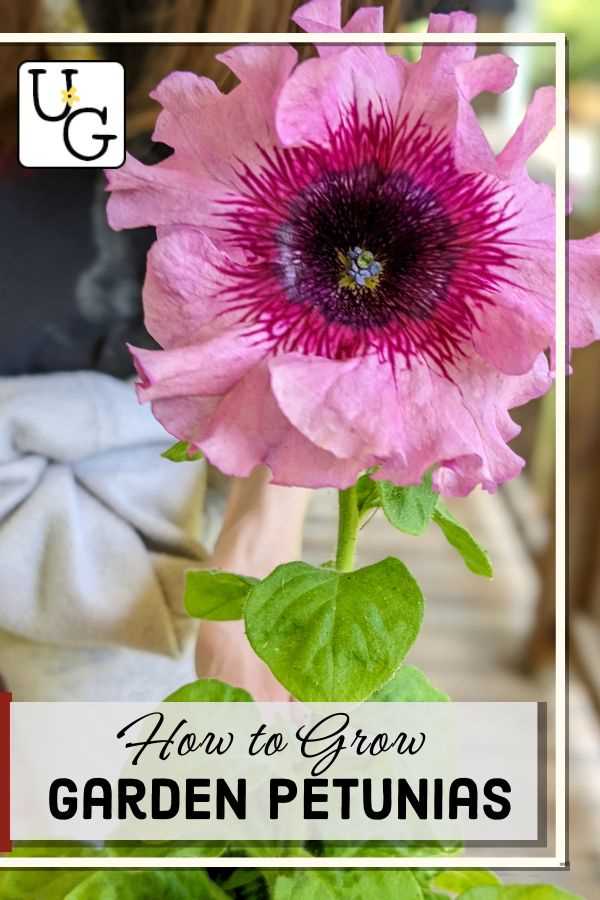
- Powdery mildew: Powdery mildew is a fungal disease that appears as a white powdery coating on leaves and stems. Provide proper air circulation, avoid overhead watering, and use fungicides to control powdery mildew.
- Root rot: Root rot is caused by overwatering or poorly draining soil, leading to the decay of the plant’s roots. Ensure proper drainage and avoid overwatering to prevent root rot.
- Botrytis blight: Botrytis blight is a fungal disease that creates brown spots, rotting flowers, and gray mold. Remove affected plant parts and improve air circulation to prevent the spread of botrytis blight.
- Virus diseases: Petunias can be susceptible to various virus diseases, such as mosaic virus and ringspot virus. Use virus-free seedlings and control aphids, which can transmit these viruses.
Regularly monitor your petunias for any signs of pests or diseases and take immediate action to prevent their spread. By implementing proper pest and disease control measures, you can protect your petunias and ensure their healthy growth and blooming.
Proper Transplanting of Petunias for Enhanced Results
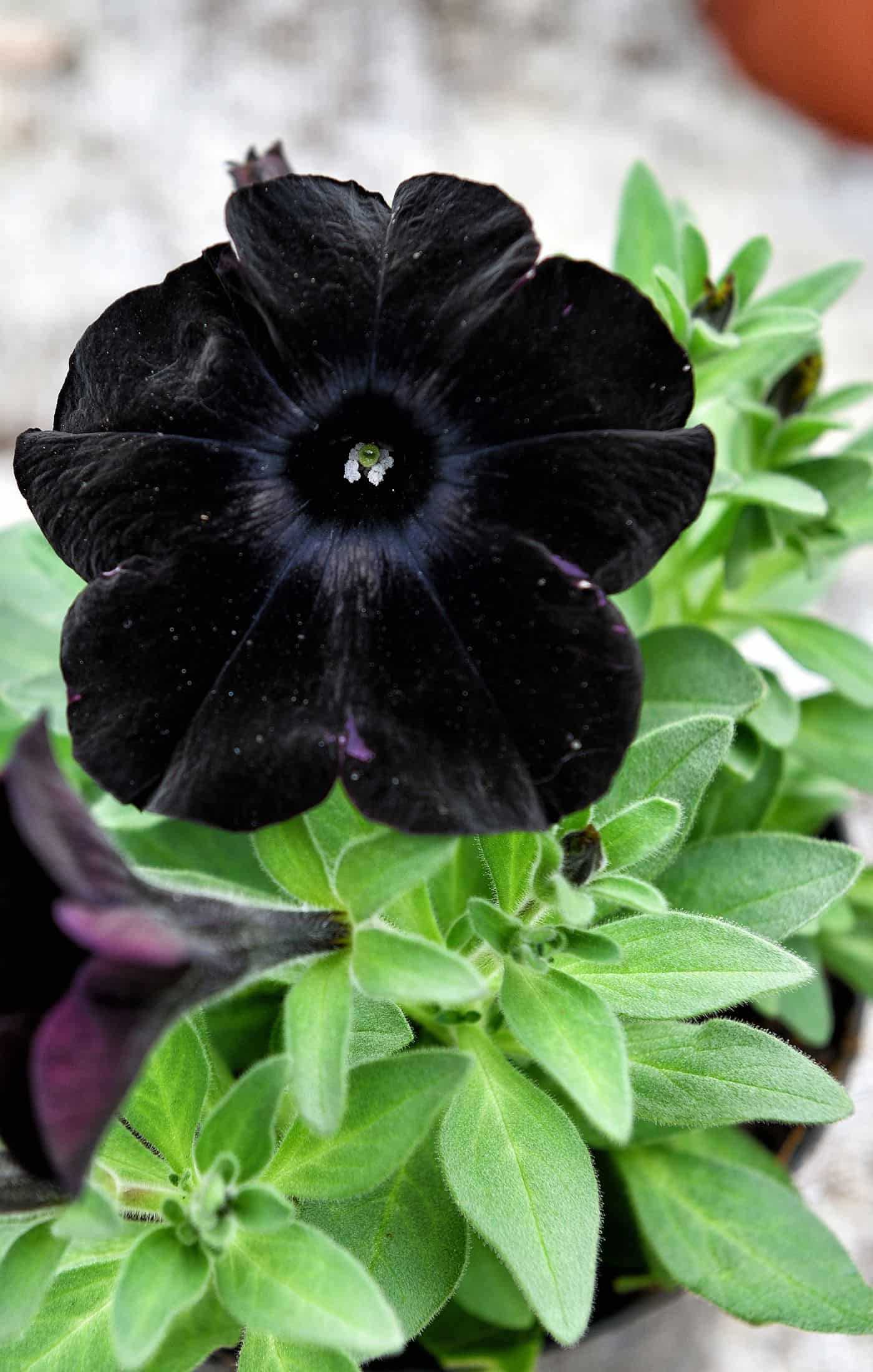
Transplanting petunias requires proper techniques to ensure healthy growth and vibrant blooms. By following the steps outlined below, you can enhance the results of your petunias and enjoy a beautiful display of colors in your garden.
Step 1: Choose the Right Time for Transplanting
Before transplanting petunias, it’s important to choose the right time. Typically, it is recommended to transplant petunias after the last frost date in your area. This will ensure that the plants have a better chance of survival and will not be damaged by cold temperatures.
Step 2: Prepare the Soil
Prepare the soil in the new planting location for your petunias. The soil should be well-draining and rich in organic matter. Remove any weeds or debris from the area, and loosen the soil with a garden fork or tiller.
Step 3: Dig a Hole
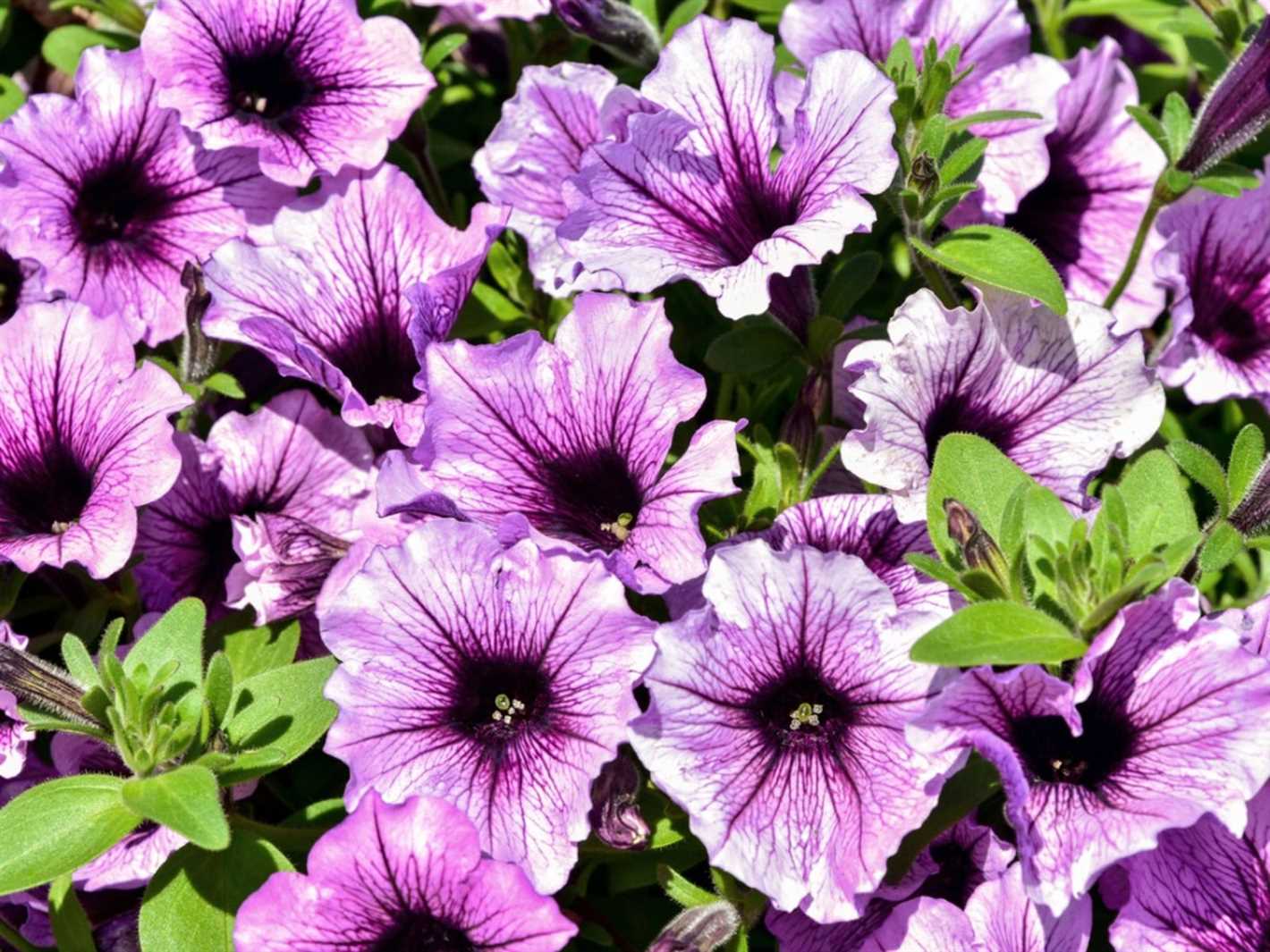
Dig a hole in the prepared soil that is slightly larger than the root ball of the petunia plant. Gently remove the plant from its container and place it in the hole, ensuring that the top of the root ball is level with the soil surface.
Step 4: Backfill the Hole
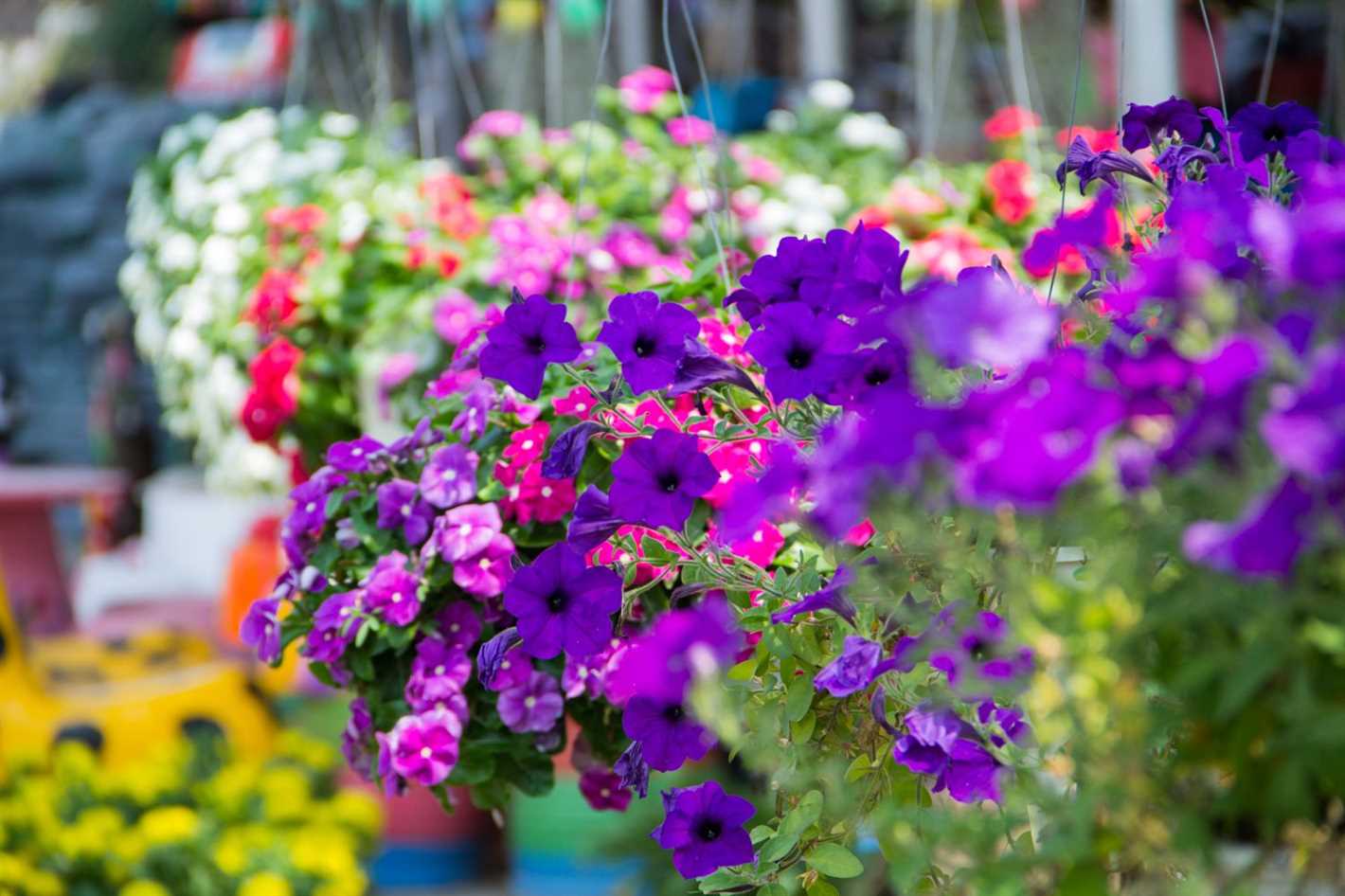
Backfill the hole with soil, gently tamping it down around the plant to remove any air pockets. Water the newly transplanted petunia thoroughly to help settle the soil and provide moisture to the roots.
Step 5: Provide Proper Care
After transplanting, it’s important to provide proper care to your petunias. Water them regularly, ensuring that the soil is evenly moist but not waterlogged. Fertilize the plants as needed to promote healthy growth and blooming.
Step 6: Protect from Extreme Weather
In extreme weather conditions, such as heavy rain or strong winds, it’s essential to protect your newly transplanted petunias. You can use mulch or row covers to shield the plants from excessive moisture or damage.
Step 7: Monitor for Pests and Diseases
Keep an eye out for any signs of pest infestation or diseases on your petunias. Regularly inspect the plants for aphids, slugs, or fungal diseases. If any issues are detected, take prompt action to prevent further damage.
By following these proper transplanting techniques, you can ensure that your petunias thrive and provide a stunning display of colors all season long.
Maintenance Tips for Long-lasting Petunia Blooms
Once your petunias are planted and growing, it’s important to provide proper maintenance to ensure long-lasting blooms and healthy plants. Here are some tips to help you maintain your petunias:
1. Watering
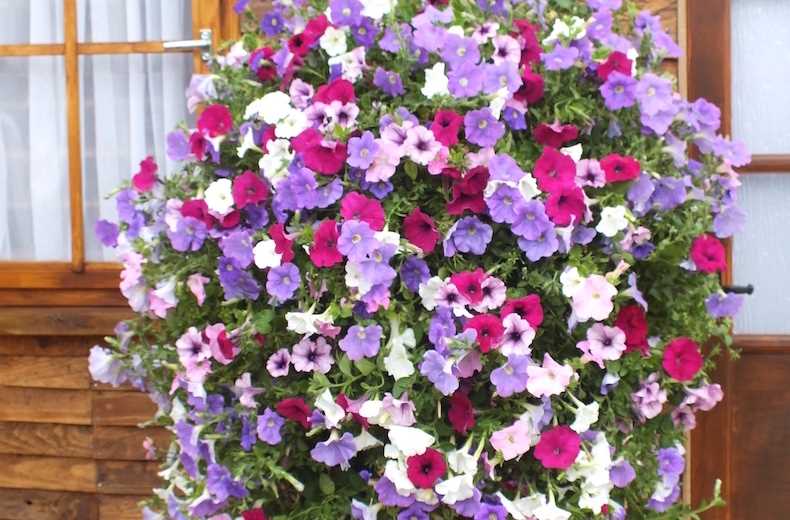
Petunias need regular watering to stay healthy and vibrant. Water deeply, allowing the soil to dry slightly between waterings. Avoid overwatering as it can lead to root rot and other diseases. Water early in the morning or late in the evening to minimize evaporation.
2. Fertilizing
Regular fertilization is essential for healthy petunia plants. Use a balanced, slow-release fertilizer or a liquid fertilizer diluted according to the package instructions. Apply the fertilizer every two to four weeks throughout the growing season to promote continuous blooming.
3. Deadheading
To encourage more blooms, deadhead your petunias regularly. This involves removing faded flowers by pinching them off at the base of the stem. Deadheading prevents seed production and redirects the plant’s energy into producing more flowers.
4. Pruning
Periodic pruning helps to maintain the shape and appearance of your petunias. Use sharp pruning shears to remove any leggy or overgrown stems. Prune the plant back by about one-third to encourage bushier growth and more compact flowering.
5. Pest and Disease Control
Monitor your petunias for pests such as aphids, slugs, and snails. If you notice any signs of infestation, use appropriate pest control methods to eliminate them. It’s also important to keep an eye out for common diseases like powdery mildew or botrytis and take prompt action if necessary.
6. Mulching
Applying a layer of mulch around your petunias can help conserve moisture, suppress weeds, and regulate soil temperature. Use organic mulches like compost or straw, and spread them evenly around the base of the plants, taking care not to cover the stems.
7. Regular Inspection
Make it a habit to regularly inspect your petunias for any signs of problems, such as yellowing leaves, wilting, or stunted growth. Early detection allows for quick intervention and prevents potential issues from spreading to other plants.
By following these maintenance tips, you’ll be able to enjoy your petunias’ beautiful blooms for an extended period, adding vibrant color to your garden or landscape.
Questions and Answers:
What is the best way to sow petunias without using sand?
Instead of sand, you can use vermiculite or perlite. These materials provide similar benefits to sand, such as improved drainage and aeration, without the risk of compacting the soil.
Why should I sow petunias without sand?
Sowing petunias without sand helps prevent soil compaction and allows for better drainage and aeration. This creates optimal growing conditions for the petunias, leading to healthier and more productive plants.
What are the alternative options to sand for sowing petunias?
There are several alternative options to sand for sowing petunias. Some popular choices include vermiculite, perlite, and coconut coir. These materials provide similar benefits to sand, such as improved soil drainage and aeration.
How do I prepare the soil for sowing petunias without sand?
To prepare the soil for sowing petunias without sand, you can mix in alternative materials like vermiculite or perlite. These materials can be added to the soil in a 1:1 ratio or as recommended by the product instructions. Make sure to mix them thoroughly with the soil before sowing the petunia seeds.
Will sowing petunias without sand affect their productivity?
No, sowing petunias without sand will not affect their productivity. Using alternative materials like vermiculite or perlite can provide similar benefits to sand, such as improved soil drainage and aeration, which are crucial for the healthy growth and productivity of petunias.







